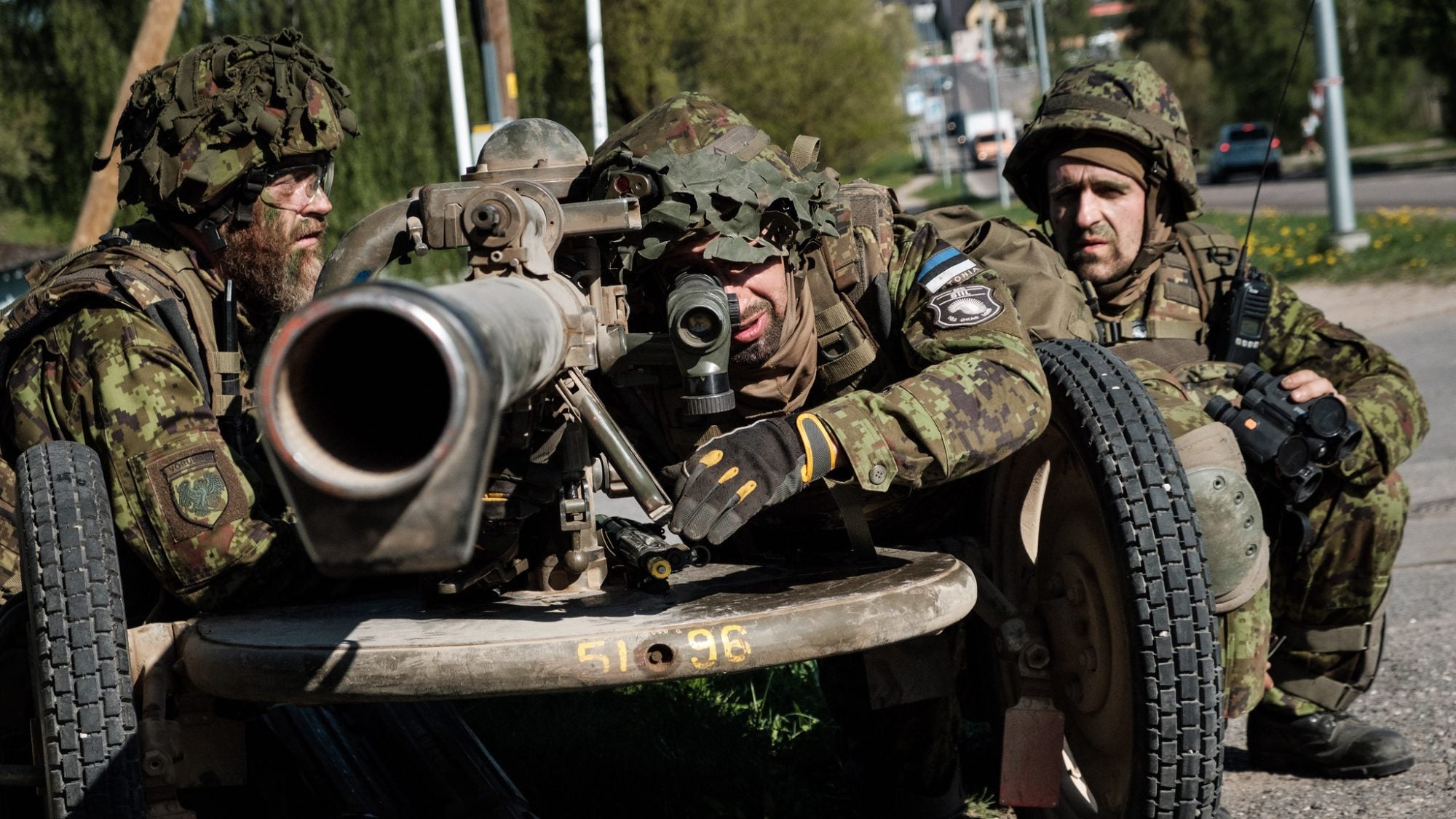
Title: NATO’s Greatest Test: Baltic Security in Trump’s Shadow
The Trump administration’s abandonment of allies and embrace of Putin’s Russia has raised pressing questions about whether Estonia, Latvia, and Lithuania can continue to rely on NATO for security. To prevent the Baltic states from becoming the next target of Russian aggression, the West must continue supporting Ukraine on the battlefield, and Europe must urgently enhance its defense spending. The Baltic states have set an example, maintaining robust defense commitments and strengthening their regional alliances.
Harsh new realities
The abrupt shift in U.S. foreign policy under the Trump administration, marked by the abandonment of Ukraine and an embrace of Vladimir Putin’s Russia, shocked NATO allies. If Russian aggression is rewarded and Ukrainian sovereignty is compromised, it would demonstrate the dominance of force. For small countries like Estonia, Latvia, and Lithuania, respect for international law and the rules-based order is essential to their security. In this transformed geopolitical environment, the Baltic states must focus on safeguarding their sovereignty and resisting Kremlin aggression.
Putin’s ambitions extend beyond Ukraine. His goal is to restore Russia’s status as a superpower, and one of his demands in pre-war negotiations with the Biden administration was the withdrawal of NATO to its 1997 borders. Such a move would leave the Baltic states vulnerable, effectively dividing Europe into spheres of influence. Troublingly, President Trump’s foreign policy approach at times appeared to align with this outlook.
For Russia, the collapse of NATO could be a more valuable prize than territorial gains. A limited attack on a border area of Estonia or Latvia could test NATO’s willingness to invoke Article Five, potentially revealing a lack of resolve. Even though President Biden has pledged to defend every inch of NATO territory, the situation evokes the 1939 dilemma of Mourir pour Dantzig (why die for Danzig?), a phrase that captured the reluctance of Western European countries to defend Poland against Nazi Germany’s aggression, questioning whether they should risk war over a distant city. A scenario in which NATO’s collective defense clause is rendered ineffective would leave the Baltic states dangerously exposed.
In response, the Baltic states must maintain their cooperation with the United States while simultaneously deepening ties with European allies. Such a balanced approach would ensure they are not overly dependent on any single partner. Meanwhile, Western countries must continue supporting Ukraine on the battlefield, recognizing that Ukraine’s resilience is critical to deterring further Russian aggression against the Baltic region.
The Baltic States: Reliable NATO Allies
The foundation of Baltic security rests on a strong reliance on NATO and the United States. This strategy is deeply influenced by the traumatic experiences of World War II when the Baltic states faced abandonment and endured brutal Soviet occupation due to a lack of reliable allies. Since regaining independence in 1991, their guiding principle has been clear: never face threats alone. This commitment has driven their successful integration into Western institutions, including membership in NATO and even the Eurozone, which further bolsters their economic and security ties.
The Baltic states have consistently demonstrated their commitment to NATO, actively participating in missions in Iraq, Afghanistan, and beyond. Estonia, for instance, has suffered combat losses in Afghanistan nearly proportional to those of the United States, underscoring its dedication. Beyond troop contributions, the Baltic states offer specialized capabilities to the alliance, particularly in the cyber domain, where their expertise is widely recognized. Their intelligence services are also highly regarded as reliable partners within NATO.
The recent accession of Finland and Sweden to NATO has significantly enhanced Baltic security. These two neighboring countries bring substantial independent defense capabilities and share a common threat perception, creating a more cohesive and defensible Nordic-Baltic region. Additionally, Finland and Sweden are members of the U.K.-led Joint Expeditionary Force, a rapid-reaction group of nine northern European NATO countries capable of responding swiftly in the Baltic Sea region.
The Baltic states also maintain close ties with Poland, whose military is expanding into the largest and best-resourced force in the European Union. This growing partnership further reinforces regional security and strengthens the Baltic states’ ability to deter potential threats.
Russian Aggression and Baltic Vulnerability
Following the Baltic states’ accession to NATO in 2004, the alliance maintained a cautious approach to avoid provoking Russia. Its initial presence in the region was limited to an air policing mission of four fighter jets. However, Russia’s annexation of Crimea in 2014 marked a turning point. In response, NATO established its Enhanced Forward Presence in the Baltic states, deploying multinational battalions in Estonia, Latvia, and Lithuania, led by the United Kingdom, Canada, and Germany, respectively. These forces served as a “tripwire” to deter Russian aggression, signaling NATO’s commitment to collective defense.
Despite this strengthened posture, the Baltic states have faced mixed signals from the United States. Under President Trump, U.S. support for NATO appeared uncertain. Trump repeatedly criticized allies for insufficient defense spending, suggesting that the United States might not protect those who failed to meet financial commitments. For the Baltic states, these criticisms seemed less threatening, given their consistent defense spending well above NATO’s two percent GDP standard—currently exceeding three percent. Baltic leaders even commended Trump for pressuring other NATO members to increase their defense budgets and announced plans to further boost their own.
Russian aggression has not been limited to conventional threats. Following the annexation of Crimea, Moscow justified its actions by claiming to protect Russian speakers—a narrative it has repeatedly used in conflicts, including in Ukraine and Georgia. This rhetoric is particularly concerning for Estonia and Latvia, which have sizeable Russophone minorities that the Kremlin has continuously sought to exploit. By framing its actions as the defense of Russian compatriots, Russia has influenced Western perceptions, leading some to accept its narrative of discrimination without questioning the facts.
Russia’s efforts to undermine Baltic sovereignty extend beyond propaganda. Since its full-scale invasion of Ukraine, Russia has escalated hybrid warfare tactics in the Baltic region, including severing undersea infrastructure cables, jamming GPS signals, conducting sabotage, and launching cyberattacks. Disinformation has spread rapidly through social media, further destabilizing the region. NATO’s response has been cautious, constrained by the complexities of technical, political, and legal attribution, as well as the risk of further escalation.
While Russia’s conventional military capacity has been weakened by heavy losses in Ukraine, analysts warn that a peace settlement could allow Russia to quickly rearm, potentially posing a renewed threat to the Baltic states within a few years.
Preparing for this possibility has come at a substantial cost for Baltic governments. To strengthen their defenses, they have raised taxes and reduced public services. These economic sacrifices, coupled with rising energy costs and declining foreign investment, have strained public support. In this environment, populist parties may gain traction, threatening social cohesion and national unity just as the Baltic states need both most.
Defending the Baltic States
The most effective way to ensure the security of the Baltic states is to provide Ukraine with all necessary support to secure a decisive victory on the battlefield. A strong, resilient Ukraine keeps Russia bogged down, reducing the threat to neighboring regions. Recognizing this, the Baltic states have been among Ukraine’s most significant supporters, contributing the highest levels of aid relative to GDP. Estonia, for example, has provided aid worth 2.2 percent of its GDP—over four times the proportion of U.S. aid (0.5 percent). Only Denmark matches Estonia’s contribution, while Lithuania and Latvia are not far behind.
While the Baltic states can encourage NATO allies to deploy troops in Ukraine following a ceasefire, they cannot afford to send their own forces, which are needed for national defense. Any NATO deployment must not weaken the Enhanced Forward Presence in the Baltic region, which remains a critical deterrent against Russian aggression.
The determination of Estonians, Latvians, and Lithuanians to defend themselves is clear. This commitment was recently underscored by their joint decision to withdraw from the Ottawa Treaty banning landmines, a step aimed at strengthening their national defenses. Baltic leaders have adopted a proactive stance, pledging to strike military targets inside Russia if attacked. After witnessing Russian atrocities against Ukrainian civilians, they are determined not to wait for liberation by NATO reinforcements. They have even ordered American missile systems for this purpose. However, with the recent pause in U.S. aid and intelligence sharing with Ukraine, the Baltic states must explore alternative suppliers to ensure their security.
Despite shifting U.S. policies, the Baltic states still maintain strong support in Congress. On March 12, 2025, Senators Grassley and Durbin introduced the Baltic Security Initiative Act, a bipartisan bill to formalize U.S. military assistance for the next three years. Baltic leaders should continue to cultivate relationships with U.S. lawmakers to maintain this support.
Given the possibility of U.S. disengagement, the Baltic states must also consider European alternatives. The concept of European strategic autonomy, long championed by France, has become increasingly relevant. Although the Baltic states once opposed this idea, fearing it would undermine NATO, they must now be open to new approaches. This includes exploring President Macron’s proposal to extend the French nuclear umbrella to European allies and supporting the European Commission’s plans for substantial investments in E.U. defense production. Over time Europe can reduce its reliance on U.S. capabilities and develop independent security mechanisms.
The Baltic states are well-positioned to shape this evolving European defense policy. Former Estonian Prime Minister Kaja Kallas now serves as the E.U. High Commissioner for Foreign and Security Policy, while former Lithuanian Prime Minister Andrius Kubilius holds the newly created post of E.U. Commissioner for Defense Industry. Baltic leaders must leverage these positions to advocate for greater European defense integration, overcoming resistance from countries like Hungary and Slovakia, which favor closer ties with Russia.
Finally, the Baltic states must continue to strengthen their resilience. Their history as neighbors of Russia has prepared them better than most Western nations to confront hybrid threats. Volunteer national guard organizations remain popular, but more can be done to secure critical infrastructure, counter disinformation, and promote social cohesion, especially among Russian-speaking minorities.
…
Andres Kasekamp is the Chair of Estonian Studies and a Professor of History at the Munk School of Global Affairs and Public Policy at the University of Toronto. He holds a PhD from University College London and is an Honorary Fellow of the Baltic Defence College. He has also served as the Director of the Estonian Foreign Policy Institute and President of the Association for the Advancement of Baltic Studies.
Image Credit: NATO North Atlantic Treaty Organization, CC BY-NC-ND 2.0, via Flickr.
Recommended Articles

On May 20, 2025, the World Health Assembly unanimously adopted the World Health Organization (WHO) Pandemic Agreement, an international treaty designed to strengthen pandemic prevention, preparedness, and…

As the Trump administration proposes a sweeping overhaul of the US foreign assistance architecture by dismantling USAID, the Millennium Challenge Corporation (MCC), and restructuring the State Department, there is an…

Amid ongoing internal conflicts in Sudan, Ethiopia, Somalia, and South Sudan, unconventional transactions involving statehood, dams, ports, and security alliances seem to be reshaping the fragile region. This article analyzes…